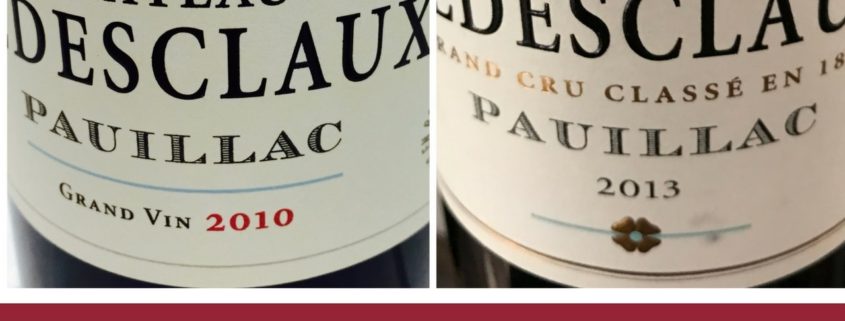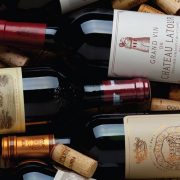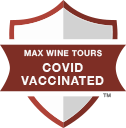Extremes in Bordeaux – 2010 vs. 2013 Classed Growth Reds
After soils, climate is the most important factor in determining what a wine will taste like. In the simplest sense, growing seasons with lots of sun produce fruity and full-bodied wines, while cloudier growing seasons produce thinner, earthier wines. Warmer seasons produce higher alcohol but lower acid wines, while cooler years produce just the opposite.
First, we can separate climate and weather. Climate is long term, like Florida is humid or Arizona is hot in the summer. The climate is a regions average, with Bordeaux having a mean July temperature of 69 degrees, and 34 inches of rain per year. Bordeaux’s coastal location ensures that the climate is both stable and temperate. There are less spring frosts and smaller temperature swings than in the interior. The climate had a huge influence on which grapes were planted in Bordeaux, as it does in every region.
Many think of heat as the most important factor for a good vintage in Bordeaux. While this is certainly important, the main contributor for a good to excellent vintage is rain, or rather lack of. The best years have been the driest years, and the poorest years have been the wettest. There are five factors for producing excellent wines:
- An early and rapid flowering to ensure even maturity and yield
- Little rain at berry set
- Adequate leaf canopy to ensure ripeness
- Late heat to bring maturity to late ripening varietals
- No Spring frosts of hail during the growing season
Within the climate, there are variations called weather. Weather is short term, such as frost overnight or rain the next day. Individual events such as frost, rain, heat spikes or hail can have devastating effects on the vines ability to produce grapes. Likewise, fine weather during flowering, and again leading up to harvest leads to yields that will be both high quality and high quantity.
The 2010 Vintage
2010 was considered a near perfect year. Spring was dry, but cold weather caused a late bud-break. However, this lost time was made up by a warmer than average April. There were a couple of other hiccups early in the season, such as rain during flowering and a localized hailstorm on May 9th. From July on, the weather was dry and warm. Most Merlot was picked before a series of storms in mid-September. This earlier pick means the wines are fresher with higher acidity. Cabernet would stay on the vine for another month, with great weather returning. Châteaux were able to pick at their leisure.
The 2013 Vintage
In contrast, 2013 was full of challenges. It started with a wetter than average January. This, coupled with a cool Spring meant the soils stayed cool and bud break was delayed. The vines had a quick window of nice weather in April, but rain was constantly on the horizon. May was the wettest in 20 years, with rain almost every day. This caused widespread coulure (some grapes did not form and bunches are loose and lighter), particularly affecting Merlot. Many thought the worst was over as July and August were warm and dry. Then in late September, a tropical storm brought heavy rains and hot, humid weather. This brought a horrible onset of rot and many grapes were lost, with some Châteaux not making wines at all. There was a race to bring in fruit before the rot set in.
Tasting
For this tasting, we focus on the “Classed” Red Wines of the Left Bank of Bordeaux.
What are classed wines? At the end of the 18th century, the leading wines from the Medoc were already understood. Napoleon’s wars, then the failure of the Bank of Bordeaux, meant that more wines were exported than consumed locally. Merchants became very powerful and began financing the growers. A classification was made official in 1855, ranking Medoc (and Sauternes) vineyards from 1st to 5th growths. This was ordered by Napoleon III for the upcoming Exposition Universelle in Paris. The list was drawn up in a couple of days from a combination of wine broker opinion, and prices the wines fetched in the market. Within the class (first growths for example) wines are categorized by descending prices. There are 5 (4+1) First Growths, 14 Second Growths, 14 Third Growths, 10 Fourth Growths, and 18 Fifth Growths, for a total of 61.
What makes the 1855 Classification unique is that it is not a mere ranking of land quality, but of the properties themselves, inevitably including the human element. It is also tied to the Chateau itself, not the vineyards owned by it. The word Château (or brand) hardly appears on the document, but because of it and the riches that followed; owners would be able to build huge country estates. Also remarkable is that the 1855 Classification has remained intact, with only a few minor changes. Only Mouton-Rothschild and Léoville-Barton are still in the same hands. The only major changes have been the addition of Cantemerle soon after the document was finalized, and the 1973 elevation of Mouton-Rothschild from 2nd to 1st growth.
These wines were tasted exactly three years apart, to ensure that they are in the same state of evolution.
Key:
Scores: 1 to 5 stars, with 5 stars being the best
First Growth through Fifth Growth from the 1855 Classification
CS = Cabernet Sauvignon
M = Merlot
CF = Cabernet Franc
PV = Petit Verdot
St. Estephe
Château Calon-Ségur 2010 – 4.5
A beauty! Medium purple color with plum skin, red berries, toffee, earth, teriyaki sauce and cedar. Tobacco makes the debut on the palate, also a touch of weediness. I love it! A complex expression of where it was grown. Definitely, buy or order! You will be rewarded if you can wait 10 years.
Château Calon-Ségur 2013 – 3.5
Let’s start by saying that 2013 was one of the worst years in Bordeaux. Bad weather during flowering, and rain and rot before harvest made for a very small crop. 85% Cabernet Sauvignon with a dense color. The signature “wet gravel” smell of Calon is definitely there, along with tomato and plum. Actually quite a ripe smell given that it is only 13% alcohol. The taste is more bell pepper, with higher acid and lower tannin than other years. Try another vintage.
Château Montrose 2010 – 5
This wine is almost blue! Really aromatic, with blueberry, mushrooms and coffee can leaping out of the glass. I don’t know what it is, but this must truly be the perfect proportions of Cabernet and Merlot. Clean but weighty. One of the best 2010 Bordelaise wines you can buy. Why do I always like the expensive ones! This will effortlessly age 30 years. Bravo!
Château Montrose 2013 – 4.5
A standout from 2013, Montrose never fails to impress! A deep, but not as obvious nose of plum, cherry, red currant, and chocolate. Definitely more fruit, than black or dried. While it is one of the more full-bodied wines of the vintage, it doesn’t have the richness or depth that the wine achieved in other years. It has little to no bell pepper flavor, but strong tannins. Long clean finish. 68%CS 29%M
Château Cos d’Estournel 2010 – 4
This property lies next door to Château Lafite. Very dark color. Mostly Cabernet nose of currant, wet tobacco, clove and cranberry. Powerful but round mouthfeel. Strong chocolate finish. Stylistically, I would say it is made in a similar fashion to Clerc-Milon. I imagine it will peak between 2025-2035. Who knows where we will be then…
Château Cos d’Estournel 2013 – 3.5
A medium intensity nose of clay, cherry and plum skin. Clay, or earth points to a cooler or cloudier year. Lean with a lotta pyrazine. High tannin. Totally opposite of the 2010 vintage.
Château Cos Labory 2010 – 3.5
Not sure what to think of this one. The nose is in a “dumb place” right now – kind of musky and funky. Not on the palate though; quite full bodied and ripe. No bell pepper here! Will probably be better in six months or a year. Drink 2016 – 2030.
Château Cos Labory 2013 – 3.5
Barrel driven aromas of tobacco and cedar seem to drive this wine. Also some mushroom, which could be from bottle age or a damp growing year. Not much fruit there at all. Lighter and easy drinking.
Pauillac
Château Pontet Canet 2010 – 4
From a biodynamic vineyard adjacent to Mouton-Rothschild. Usually known for its tobacco aroma, the 2010 has it all; creme de cassis, dried violets and cedar. Full bodied and massive. The ripe nose and fruity palate will make it enjoyable early on, yet it has enough fuel to last another 50 years. Quite good. I believe Robert Parker Jr gave it a perfect 100.
Château Pontet-Canet 2013 – 4
Across the street from Mouton Rothschild, Château Pontet-Canet is a Fifth Growth that should be a second or third. Being one of the larger estates in Bordeaux enables them to be more selective with fruit for the Grand Vin. A Light nose, but the bottle had just been opened. I’m sure the nose would expand as I found it to be quite hefty and substantial. Tastes full and fruity, with plum currant and strawberry. Strong tannin. This one can age 20 years. 65%CS 30%M 4%CF 1%PV
Château Pichon-Longueville Baron 2010 – 4.5
Rich blackberry, currant, truffle, gardenias, mineral and balsa wood aromas. The rare combination of a dry but cool season has given this wine an abundance of everything; acid, fruit, alcohol and tannin. Long spicy finish. It has class, and must certainly be one of the standouts in 2010.
Château Pichon-Longueville Baron 2013 – 4
This Second Growth estate sits on a south facing hill of pure gravel. For this reason, it smells powerful and muscular, like tomato, plum, green fig and vanilla. Less body than other years, I would categorize this as a tannin based wine. Beautiful long finish. One of the best 2013’s you can buy.
Château Pédesclaux 2010 – 3.5
Dark color, typical for the 2010 vintage. More of a Napa Cabernet nose of blackberry, chocolate and meat. Expecting a blown up extracted wine, but not the case. Medium bodied and brisk. Drink this one before other Pauillac wines.
Château Pédesclaux 2013 – 3
A more obscure Fifth Growth. Poor weather during flowering adversely affected Merlot grapes, and it is evident as this wine is 2/3 Merlot. A light nose of mostly roots or mesquite wood. It does have a pleasant taste, but I wouldn’t age this one. Not memorable.
Château Lynch-Bages 2010 – 4
A more muted nose initially. Eventually, some blackcurrant comes out, which points to the wine being heavily Cabernet. Concentrated with tons of both fruit and barrel tannin. I thought it tasted hot, and was surprised to see only 13.5 degrees of alcohol. Drink before 2040.
Château Lynch-Bages 2013 – 4
A Fifth Growth, but this property (which has remained intact since the 16th century) deserves to be a Second or Third Growth. A dark color leads to a nose of hickory, earth, dry tobacco and roasted coffee. Wasn’t sure I would like the 2013 until I tasted it, and it’s great! Pleasant fruit on the palate, more red than black. A good balance with a long espresso flavored finish.
Saint-Julien
Château Beychevelle 2010 – 4
Sweet cored nose of cherry jam, with charred meat and squashed clay notes. Lighter in taste with some cedar notes and a lengthy finish. More elegant and restrained, but might not age as long as others. Drink within ten years.
Château Beychevelle 2013 – 4
Founded in 1565, this Fourth Growth has 185 acres under vine. However, the Grand Vin comes from the best 50 acres directly behind the Château. Smells beautiful, like black cherry, cardamom and milk chocolate. Spicy fruit and more unripe tannin. A touch austere now, I think this will age into an elegant wine. 55%CS 36%M 9%PV
Château Branaire-Ducru 2010 – 4
Very deep color, with a unique nose of sausages and fennel. Makes me want to eat a bratwurst! Eventually, some blueberry, cedar and creamy coffee make themselves known. Great tannin on this one, but I wouldn’t touch it for another ten years. You will be rewarded!
Château Branaire-Ducru 2013 – 3
A Fourth Growth, Branaire is often forgotten when discussing wines of Bordeaux. The nose is fruit driven, with raspberry, red currant, cherry and other just-ripe red fruits. Also a touch of balsamic aromas. This is a more high acid tart wine and will benefit from aging. 63%CS 31%M 5%PV 1%CF
Château Langoa-Barton 2010 – 4
First time I’ve ever had this one. The nose has wet gravel, red berries, and rustic wood in descending order of strength. Middleweight (as is often the St. Julien style), but fierce tannin and a very pleasing gravel finish. Maybe it is just me, but I noticed lower acidity here. Another beast of a wine -hide and forget about this one for at least 15 years.
Château Langoa-Barton 2013 – 4
A smaller Third Growth estate, that blends the best of St. Julien and Pauillac. It has a powerful nose of cherry, milk chocolate, and earth. A bit medicinal as well. A ripe wine for the vintage, but there is a lot of freshness too. A beautiful mineral finish set this wine apart. 65%CS 30%M 5%CF
Château Léoville-Barton 2010 – 4
The smallest of the three Léoville Estates and with the oldest vines. Inky color, and a muted nose of toffee, rustic wood, redcurrants and tobacco. Fresh, balanced and concentrated – no compromise here. Very strong (but fine and high quality) tannin. Another for the cellar. Drink after 2030.
Château Léoville-Barton 2013 – 4
Same ownership as Langoa-Barton, but Léoville-Barton uses a higher proportion of Cabernet and is little better in my opinion. The nose stands out amongst its peers for its power, with vanilla, blueberry, dark cherry and coffee. Dense but tannins not overpowering. This wine is ready now or can age another 15 years. Second Growth, 85%CS 15%M
Château Léoville-Las Cases 2010 – 5
A transcendental experience. The biggest piece of the Léoville division, but no Chateau – just the stone gate. Lots to draw you into the glass, including strawberry, a gravel driveway after rain, leather, vanilla bean and rose tea. On the palate, this wine crackles with energy and freshness. It is completely seamless from attack to finish, and will leave a smile on your face. Best 2010 Claret in St. Julien, and one of the greatest in all Bordeaux. Approachable now, and will age to 2050.
Château Léoville-Las Cases 2013 – 4.5
This might be my favorite Château in Bordeaux, and as close to perfection as any of the first growths. And perfection is what they are aiming for. They often declassify over 50% of their crop in good years and were the first to introduce a third tier wine. The 2013 has a bright ruby color, and a beautiful well integrated nose of currant, licorice, chocolate cosmos, meat and star anise. Tastes like bitttersweet chocolate. Not much fruit but a great dusty finish.
Château Léoville-Poyferré 2010 – 4
What a great opportunity to taste the three Léoville estates side by side by side and compare! Poyferre is run by well-known enologist Michel Rolland. Strong cedar nose, with cardamom and star anise lurking in the background. Makes for an exotic wine. The densest of the three properties. Will continue to improve for another eight years.
Château Léoville-Poyferré 2012 – 3.5
They say Second Growth Poyferré possesses the best soils in all St. Julien, yet I never like it as much. The nose, although not fruity, was complex with a combination of savory and herbaceous. Mesquite, cedar, sage and scrub were some of the aromas that let themselves be known. The taste, however, was more unripe and a little medicinal.
Margaux
Château Boyd-Cantenac 2010 – 4.5
Perhaps a more subdued and delicate nose than its neighbors; a little time in the glass coaxes out flavors of plums, toast, blueberries and mint. Medium bodied with lower alcohol and a very long finish. Elegant and pleasing. More traditional than Brane-Cantenac next door.
Château Boyd-Cantenac 2013 – 3.5
Nose of tomato, plum, earth and bitter chocolate. It is a light, quaffable wine. A great wine for a restaurant as it is ready to drink upon opening. Lighter than the 2010 for sure, so I would rather enjoy this one sooner than later. Third Growth 66%CS 29%M 2%CF 3%PV 13%
Château Brane-Cantenac 2010 – 4
Very dark purple. Nose is strongly tobacco, with some currant and cedar as well. More modern in style, with a full body, creamy mouthfeel and mellow tannin. Fresh with good acid, indicative of a cool but dry growing season.
Château Brane-Cantenac 2013 – 4
Brane-Cantenac is a large second Growth whose history dates back to the early 18th century. The wine has been well regarded for centuries. Smells like Cabernet, as in currants, blackberry, iron and chocolate. Full body, high acid, high tannin – a big wine all the way around. Has the concentration to age. Drink 2020-2030. 84%CS 14%M 2%CF
Château d’Issan 2010 – 4
Strong, almost sweet nose of stewed black plums, cherry compote, wet tobacco and cedar planks. This sweetness is all but gone on the palate, which is mouth-coating and dry. A nice balance between austere and super ripe. More fruit tannin than oak tannin, might need another 20 years to develop.
Château d’Issan 2013 – 3.5
One of the most beautiful châteaux in Bordeaux, dating from the 17th century. It has a delicate, yet low toned nose of tobacco, blackberry and toast. A softer more delicate wine for sure – medium bodied and less tannin. Drink by 2023. Third Growth 60%CS 40%M
Pessac-Leognan
Château Smith Haut Lafitte 2010 – 4
109 acres spared from the urban sprawl of Bordeaux city! Half fruit/half earth nose, with gravel, blackcurrant, graphite, blueberry and dusty earth standing out. Perfect use of oak. Lighter than Haut-Bailly, but still with ample tannic force. Will continue to improve over the next 20 years.
Château Smith Haut Lafitte 2013 – 3.5
Never a huge wine, this estate focuses on elegance and finesse. Nice chocolate and mineral nose. Ripe and round despite the poor vintage in Bordeaux. Pleasant but doesn’t have the structure to age decades. Sweeter fruit – a little more new world style. 55%CS 35%M 10%CF
Findings:
Looking at the numbers, we can easily deduce that 2010 was the better year. Although 2013 tied it 7 out of 18 times (38%), at no time did 2013 ever exceed it.
2010 had an average score of 4.14, while the average score for 2013 wines was 3.75. Of the 36 wines listed above, there were two wines with perfect scores, both in 2010. There were also five wines with a score of 4.5, with the slight edge also going to 2010. However, the two 4.5 wines from 2013 (Château Montrose and Château Léoville-Las Cases) cost about a third less, and represent the better value.
In the end, weather was the differentiating factor. Near ideal weather conditions in 2010 created wines that were deeply colored, full-bodied and high in alcohol. The wines are fruity and bright. Many have the concentration to age 20 or more years and will continue to improve in the bottle.
2013 on average, produced medium bodied, medium tannin and medium alcohol wines. 2013 exhibited more earthy aromas and tastes. Roots, mesquite, hickory, clay and medicine add complexity for sure, but some wines are lacking the fruit component evident in high score years. 2013’s saving grace is its high acidity, and this will enable the more concentrated wines to age gracefully. However, about half of the wines were on the lighter side. This lack of concentration makes them ready for earlier consumption.
What I have learned is that in good years, everyone (at this level) makes good wine; it is the challenging years that set apart the best Châteaux. There are seven wineries that had the same score for both years (Cos Labory, Pontet-Canet, Lynch-Bages, Beychevelle, Langoa-Barton, Léoville-Barton and Brane Cantenac). While across the board in reputation and price, they represent the surest bet when ordering a bottle of wine.
At its best, Bordeaux is the model for fine red wine. At its worst, it is thin and vegetal and will not age. The poor years make you appreciate the good ones that much more. This is reflected in price, with some years costing several times as much as others. To conclude, 2010 was an excellent year across all Bordeaux, however, you will have to pay for it. 2013, while not considered as classic, is full of hidden gems, but you need to be more informed when making purchases.



 MWT Vaccinated
MWT Vaccinated

